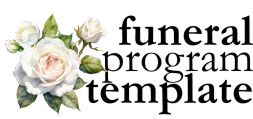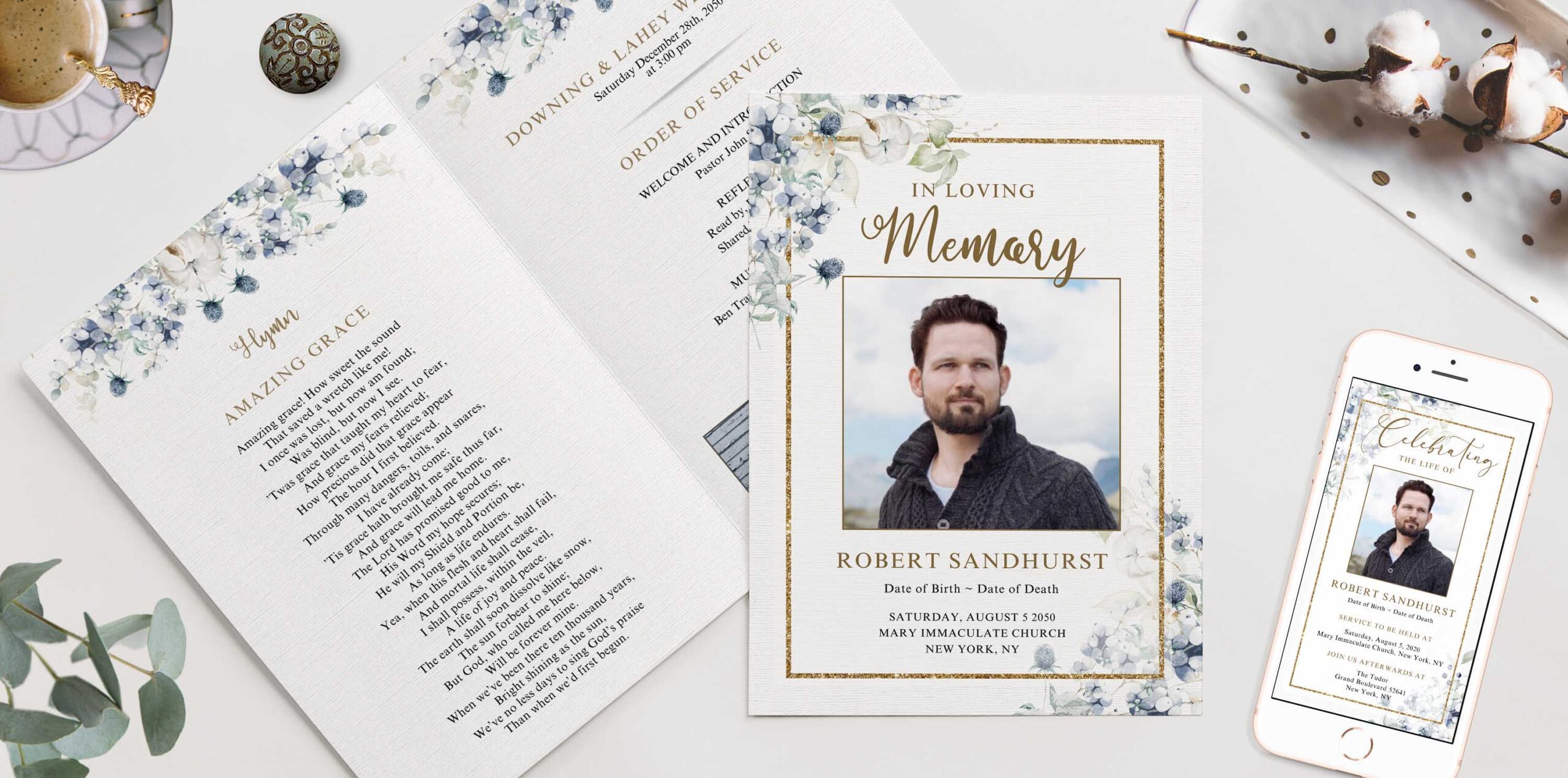
A programme for a funeral should be created to ensure that all of the details needed for a meaningful service are included and organized in a thoughtful way. Typically, a programme for a funeral should include basic information such as the date and time of services, obituary, pallbearers, order of service, and eulogy.
When creating an example of a funeral program, there are a few key elements to consider. First, include the name of the deceased and any other important information such as birth date, death date, and any other details that may be meaningful for those attending.
Include the names of individuals or groups who will be participating in the service such as the officiant, pallbearers, musicians, etc. This will help to set the tone and ensure that everyone knows what to expect during the service.
Skip Ahead
- 1. How do I make a programme for a funeral?
- 2. What do you put on a funeral program?
- 3. What is the beginning of a funeral service called?
- 4. What is the end of a funeral called?
- 5. How do you honor a loved one at a funeral?
- 6. How do you say thank you in a funeral program?
- 7. How do you make a funeral announcement?
The order of service should be clearly outlined so that everything is done in a respectful manner and no steps are missed. This typically includes prayers, readings from religious texts, music selections, eulogies, etc. It can also include an element of personalization such as sharing a story about the deceased or having a moment of silence.
Finally, consider adding a photo of the deceased to the programme for a funeral. This can be an emotional reminder for those attending and help provide closure during this difficult time.
When creating a programme for a funeral , it is important to keep in mind that they should reflect the wishes of the deceased and their family while also providing a meaningful way for friends and family to remember the deceased. It is important to choose a programme for a funeral template that expresses the personality of the deceased, as well as one that will be easy to follow and understand for all attendees.
1. How do I make a program for a funeral?
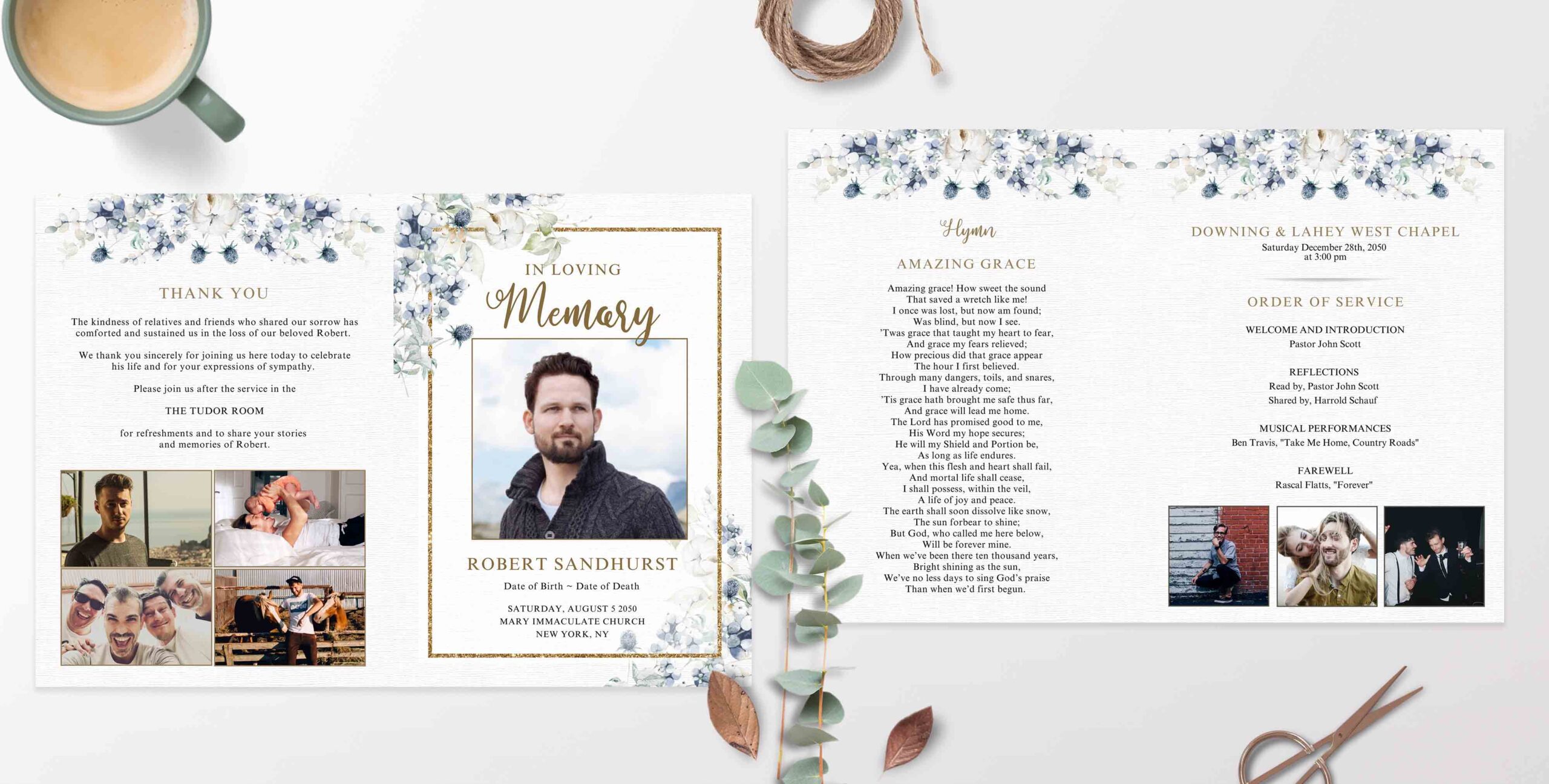
- How do I make a program for a funeral? The first step is to gather all of the necessary information for the program such as the name of the deceased, dates of birth and death, order of service, any readings or music that will be included. Once you have gathered this information, you can begin creating the program.
- Using a professional programme for a funeral template can greatly assist in the creation of a programme for a funeral, making the task significantly easier. A well-designed template provides a structured framework that presents all required elements in a coherent and aesthetically pleasing manner. Rather than starting from scratch, you can simply fill in your specific details into the pre-arranged sections.
- Templates often come in various styles and themes, catering to different preferences and religious or cultural practices. They provide consistency, ensuring that the layout remains professional and polished without requiring design skills. Moreover, templates can save time and reduce stress during a period where these resources are particularly precious. They also allow for personalization, with spaces to upload own photos, choose fonts or colors, and write personal tributes.
- In sum, a professional programme for a funeral template simplifies the process, helping you create a meaningful and respectful tribute that adheres to the necessary protocol while also capturing the unique life and spirit of the departed.
2. What do you put on a funeral program?
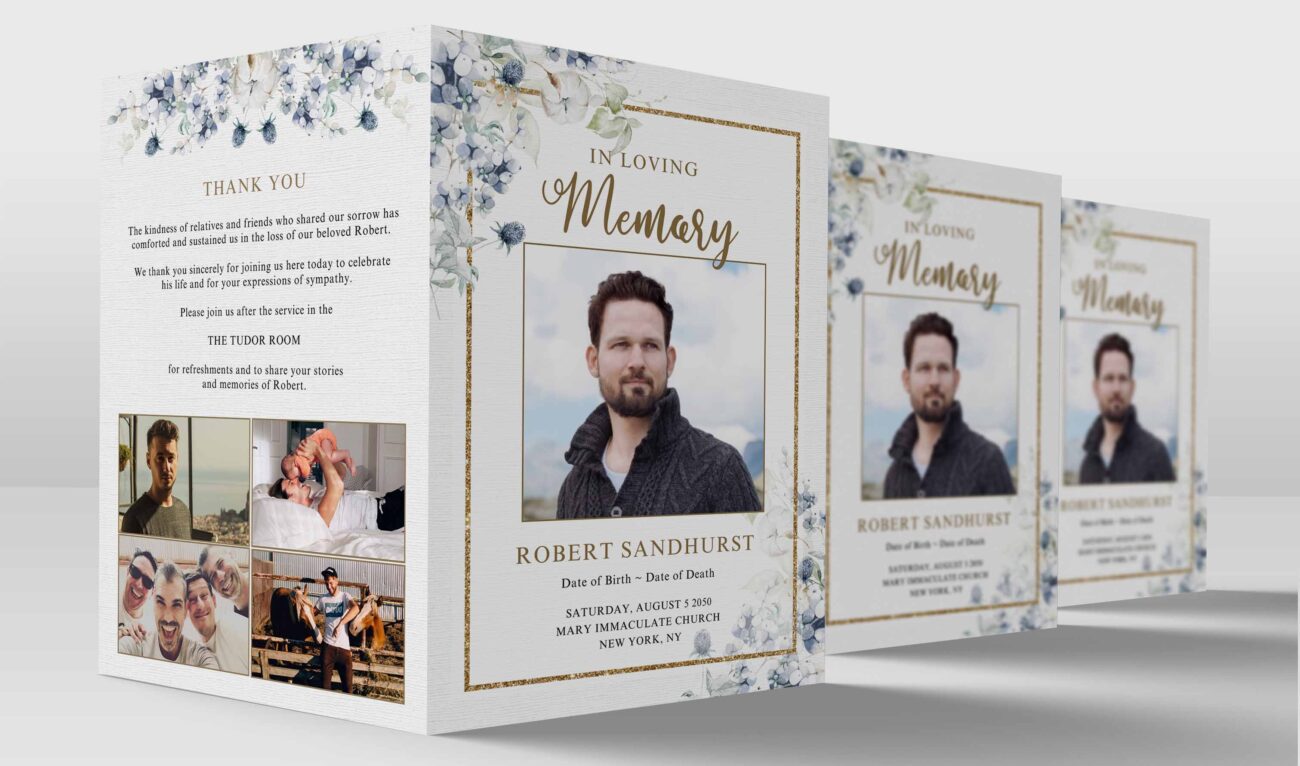
What do you put on a funeral program?
The programme for a funeral can include a variation of the following elements:
- Front Cover of a Programme for a Funeral: This typically has the full legal name of the deceased, the dates of birth and death, and a photo. Some examples of wording for this section could be “In Loving Memory of [Name]”, “Celebrating the Life of [Name]”, or “Honoring the Life of [Name]”.
- Order of Service: This outlines the flow of the funeral or memorial service. An example of this could include “Musical Prelude, Words of Comfort, Readings, Eulogy, Closing Prayer, and Musical Postlude”.
- Obituary: A brief biography of the deceased, highlighting significant moments in their life. The wording could be something like, “Born in [Place] on [Birthdate], [Deceased’s Name] lived a life full of love, joy, and adventure. They are remembered for their [qualities] and their love for [interests, hobbies or passion].”
- Example Obituary for programme for a funeral:
“Born in the vibrant city of New York on September 2, 1950, John A. Smith navigated a life full of wonder, resilience, and love. John’s passion for music was ignited at a young age – a gift that he cherished and shared with the world throughout his life. He graduated from the Juilliard School in 1972, marking the beginning of a remarkable career as a virtuoso violinist. John played in numerous orchestras, leaving a lasting legacy in concert halls worldwide.
Beyond his professional achievements, John was a devoted father, a loving partner, and a steadfast friend. His infectious laughter and boundless kindness will be fondly remembered by everyone lucky enough to have known him. John’s love for life, his music, and his family will continue to resonate in the hearts of all who loved him.
John passed away peacefully on March 28, 2022. He is survived by his loving partner, Lisa; his children, Sophia and Alex; and his grandchild, Max. As we gather today to celebrate John’s life, we remember his love for music and his ability to touch the hearts of many through his art.”
- Eulogy: This is a speech given in honor of the deceased that typically provides a more intimate look at their life. It’s usually given by a close family member or friend.
- Poem or Reading: This could be a favourite poem or reading of the deceased, or something that captures their spirit. For instance, “Do not stand at my grave and weep, I am not there; I do not sleep.” – Mary Elizabeth Frye.
- Acknowledgements: This is a space to thank those who have provided support, either through their presence at the service or in other ways.
- Photos or a Collage: These provide a visual tribute to the deceased and can be accompanied by captions or brief notes. You may choose to include photos in a programme for a funeral from different stages of their life, showcasing their journey and achievements.
Remember, the aim of a programme for a funeral is to honor and celebrate the unique life of the person who has passed. As such, the wording and content should reflect their personality, values, and the impact they made on the lives of those around them.
3. What is the beginning of a funeral service called?
The beginning of a funeral service is traditionally known as the “Visitation” or “Viewing.” This is an opportunity for friends, family members, and others who cared for the deceased to gather and pay their last respects. It often involves a viewing of the deceased in a casket, though this can vary based on cultural practices or personal preferences.
Some prefer a closed casket or even a memorial service without the body present. During the visitation, attendees may share condolences, exchange stories, and provide emotional support to one another. This solemn gathering sets the tone for the funeral service, as it initiates the process of saying goodbye and celebrating the life that was lived. This generally takes place the evening prior to the funeral service.
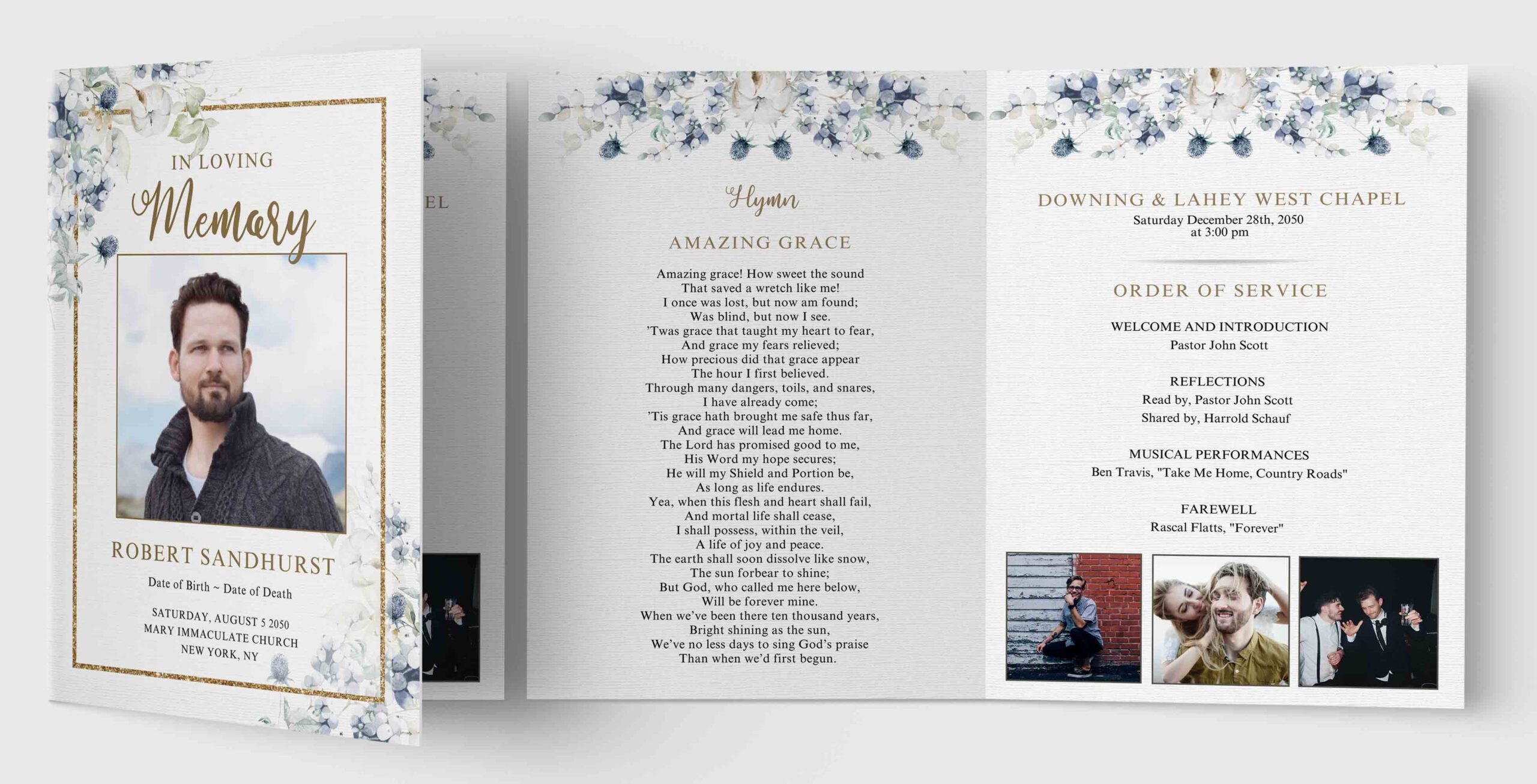
4. What is the end of a funeral called?
The end of a funeral service is known as the “Funeral Recessional.” This is the formal exit of the family and attendees from the funeral service area. Depending on the cultural and religious practices, the casket or urn may be led out by the officiant, followed by the family, pallbearers, and then the congregation.
In a programme for a funeral, the Funeral Recessional may be listed as:
- Funeral Recessional: Here, you can specify the piece of music to be played or the song to be sung while the attendees depart. It could be a meaningful song that was particularly cherished by the deceased. For example, “Amazing Grace” is a commonly chosen recessional hymn.
- Final Resting Place: If the burial or interment follows immediately after the service, details can be provided here. This might include the address of the cemetery and the expected time of arrival.
- Post-funeral Gathering: If there is a gathering planned after the service, details such as location, time, and any requests (like ‘in lieu of flowers’) can be mentioned under this section.
Remember, the Funeral Recessional is the last opportunity to bid farewell in the formal service, so it is important to choose elements that reflect the life and memory of the deceased.
In terms of expressing gratitude to the mourners who attended, there are a variety of ways to do so. This could range from a simple “Thank you for your support during this difficult time” to a more personal note such as, “Your presence at the service was a comforting reminder of the deep love and respect felt for [the deceased]. Thank you for sharing in our sorrow and helping us honor [their] memory.”
As for music, the choice often reflects the deceased’s personal taste, or music that has a special significance to them. Classic choices include pieces like “Ave Maria”, “Amazing Grace”, or “Over the Rainbow”. More contemporary songs, like “Supermarket Flowers” by Ed Sheeran or “See You Again” by Wiz Khalifa feat. Charlie Puth, have also become popular in recent times.
Regardless of the choice, the farewell music serves to provide a reflective and poignant ending to the service, allowing everyone to say their last goodbye in a personal and meaningful way.
5. How do you honor a loved one at a funeral?
Honoring a loved one at a funeral can take several forms, allowing for personal and meaningful tributes. Here are a few examples:
- Sharing Personal Anecdotes: A heartfelt way to honor a loved one is by sharing personal stories during the eulogy or memorial service. These stories can highlight their unique qualities, achievements, or even amusing moments that encapsulate their spirit. Your programme for a funeral can include these stories, giving friends and family a keepsake to remember your loved one.
- Displaying Personal Belongings: Items that had significant meaning to your loved one – such as a piece of jewelry, a favourite book, or a cherished hat – can be displayed at the service. These tangible reminders can help attendees feel a deeper connection to the deceased.
- Creating a Memory Table: A table filled with photos, mementos, and items that represent your loved one’s life and passions can be a poignant and visual way to honor them. Guests can take a moment to reflect upon the displayed items and the memories they bring up.
- Releasing Balloons or Doves: This symbolic gesture, often done outdoors at the end of the service, can provide a sense of closure and a beautiful, shared moment of remembrance.
- Planting a Tree or Flower in their Memory: A living tribute like a tree or a flower can continue to grow and bloom in their memory, providing a lasting reminder of the life they led.
These are just a few examples, and the best way to honor a loved one will always be the one that feels most fitting and meaningful to you and those who loved them.
6. How do you say thank you in a funeral program?
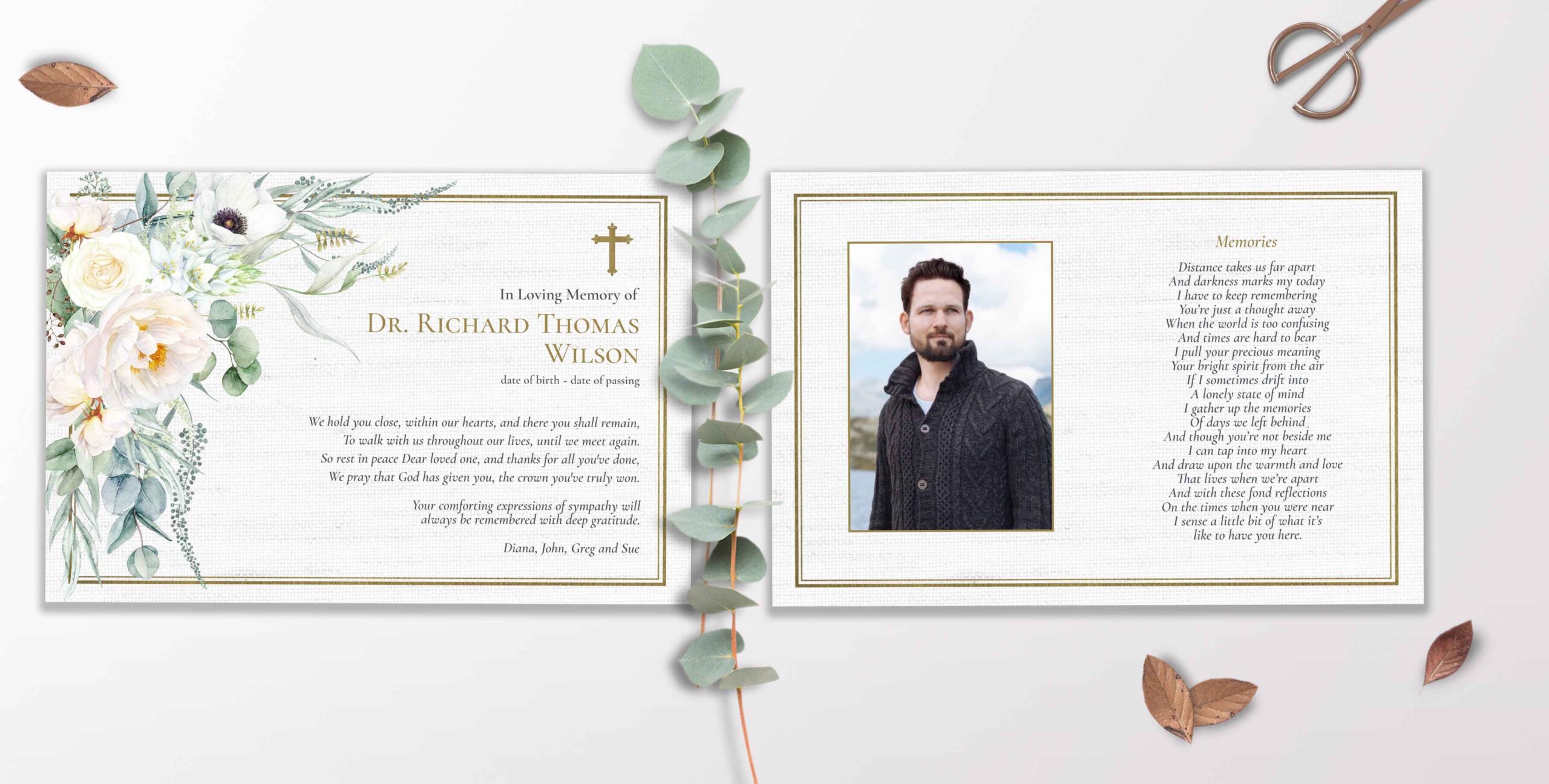
the funeral to express gratitude to those who offered support and attended the service. Antique White Roses Funeral Thank You Card Template
Incorporating a thank you message in a programme for a funeral can be a respectful and heartfelt way to express gratitude to those who have offered their support during a difficult time.
- In the Acknowledgment Section: This is the traditional place for thank you messages in a programme for a funeral. Here, you can express gratitude to everyone who has been supportive, or you can identify specific individuals or groups. Example: “The family of [Deceased’s Name] wishes to express their heartfelt thanks for the kindness and support shown during this difficult time.“
- In the Closing Remarks: This portion of the programme for a funeral offers a moment to thank guests for their presence and participation in the service. Example: “As we conclude this service, we’d like to extend our deepest thanks to everyone who has joined us today to celebrate [Deceased’s Name]’s life.“
- In a Separate Thank You Page: If you have more extensive thank you messages or if the deceased had pre-written thank you notes, you can dedicate a full page in the program to these sentiments. Express your gratitude after the funeral by sending out elegantly designed thank you cards, crafted with a funeral thank you card template.
- In Memorial Donations: If memorial donations have been made, you can acknowledge and thank the contributors in the program. Example: “We sincerely appreciate the donations made in honor of [Deceased’s Name]. Your generosity will ensure their memory lives on in meaningful ways.“
- In an Obituary or Life Tribute: Thanking people within the narrative of the deceased’s life can be a heartfelt way to show appreciation.
Remember, the key is to keep the message sincere and from the heart. Grieving is a personal process, and your expressions of gratitude should reflect that personal touch.
7. How do you make a funeral announcement?

Creating a funeral announcement typically involves the following steps:
- Start with the Deceased’s Full Name and Dates: Begin the announcement with the full name of the deceased, their birth date, and the date of their passing. This is essential information that needs to be included. Example: “It is with heavy hearts that we announce the passing of [Deceased’s Full Name], born on [Birth Date], who departed this life on [Date of Death].”
- State the Time and Location of the Funeral Service: Provide the date, time, and location of the funeral service. It’s important to give clear, concise details to avoid any confusion. Example: “A service to celebrate [Deceased’s Name]’s life will be held at [Location], on [Date] at [Time].”
- Include Details about the Reception or Committal Service if Applicable: If there will be a reception or a graveside service following the funeral, include these details. Example: “Following the service, committal will take place at [Location]. A reception will then be held at [Location].”
- Provide Information for Floral Tributes or Donations: If you would prefer for people to make donations in lieu of flowers, specify the details in the announcement. Example: “In lieu of flowers, we kindly ask for donations to be made to [Charity/Organization Name] in memory of [Deceased’s Name].”
- End with a Personal Note or Message: Close the announcement with a personal note or message, which could be a favorite quote of the deceased or a simple heartfelt message from the family. Example: “We wish to express our gratitude for your support during this difficult time and invite all who knew [Deceased’s Name] to join us in celebrating their life.”
Remember, an announcement should be informative but also convey the importance of the event and the significant loss experienced.
A funeral announcement, often referred to as a funeral invitation, is a formal communication typically sent by the bereaved family or close friends of the deceased. This document serves to inform others of the death and provides essential information about the upcoming funeral service.
It may include the date and location of the service, details about the reception or committal service, and instructions for floral tributes or donations. A funeral invitation is more than just an informative note; it is a heartfelt call to gather and share in the memory of the deceased, offering an opportunity for loved ones to express their grief, celebrate the life lived, and find mutual comfort during a challenging time.
This invitation can be a crucial step in the mourning process, as it brings together a supportive community to commemorate the life and legacy of the deceased.
Nowadays, a prevalent choice for funeral invitations is a customizable template that enables you to effortlessly share the vital details through messaging on a phone or posting on Facebook.
